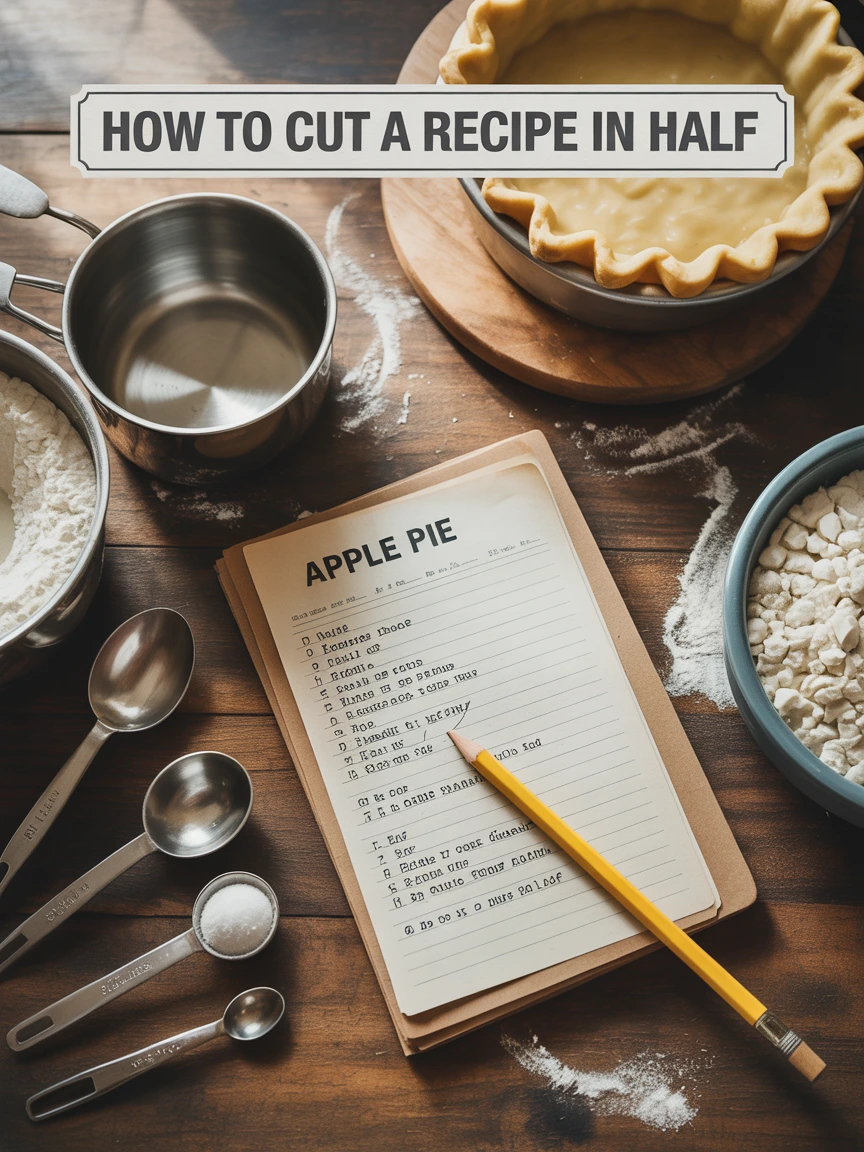Why You’ll Love This Recipe
How To Cut A Recipe In Half Poster Whether you’re cooking for one, experimenting in the kitchen, or simply don’t want leftovers, knowing how to cut a recipe in half is a valuable kitchen skill. This easy-to-follow guide helps you halve ingredients with precision, avoid waste, and maintain the flavor and texture of your favorite dishes. Say goodbye to awkward measuring and hello to confident cooking!
Ingredients
Here’s a simple conversion chart for halving common measurements:
- 1 cup → 1/2 cup
- 3/4 cup → 6 tablespoons
- 2/3 cup → 1/3 cup
- 1/2 cup → 1/4 cup
- 1/3 cup → 2 tablespoons + 2 teaspoons
- 1/4 cup → 2 tablespoons
- 1 tablespoon → 1 1/2 teaspoons
- 1 teaspoon → 1/2 teaspoon
- 1/2 teaspoon → 1/4 teaspoon
- 1/4 teaspoon → 1/8 teaspoon
For eggs:
- 1 large egg = about 3 tablespoons
- Half an egg = 1 1/2 tablespoons (beat the egg first, then measure)
Directions
- Use dry measuring cups for dry ingredients and liquid measuring cups for wet ones.
- When halving an egg, crack it into a small bowl, beat it thoroughly, then use half the volume.
- For tricky measurements like 1/3 or 2/3 cup, use tablespoons to be more accurate.
- Round down slightly when halving strong spices or baking powder/soda to avoid overpowering.
- Keep a printed or digital version of the halving chart nearby while cooking.
Servings and Timing
Cutting a recipe in half will also reduce your servings and sometimes your cooking time. Here’s what to expect:
- Servings: Typically half the original (e.g., 4 servings become 2).
- Cooking Time: May be slightly shorter, especially for baked goods — start checking for doneness earlier.
Variations
While this chart works across most recipes, here are a few considerations for different types of cooking:
- Baking: Precision is key. Use exact measurements and avoid substituting or guessing.
- Soups and Stews: More forgiving — you can eyeball many ingredients.
- Sauces: Adjust seasoning to taste after halving.
- Egg-based dishes: Consider using liquid egg substitute for easier measuring.
Storage and Reheating
Halving recipes helps avoid leftovers, but if you still have some:
- Store in airtight containers in the refrigerator for 3–4 days.
- Reheat soups, stews, and casseroles gently on the stovetop or microwave, adding a splash of water if needed.
- For baked goods, reheat in a toaster oven to retain texture.
FAQs
Q: How do I measure half of 1/3 cup?
A: Use 2 tablespoons + 2 teaspoons.
Q: What’s the best way to halve an egg?
A: Beat the egg and measure out 1 1/2 tablespoons for half.
Q: Can I eyeball ingredient halves?
A: For non-baking recipes, yes. For baking, stick to precise measurements.
Q: Do I need to adjust oven temperature when halving a recipe?
A: Usually, no. Keep the temperature the same, but check for doneness earlier.
Conclusion
Cutting a recipe in half doesn’t have to be complicated. With this handy chart and a few simple tips, you can scale down recipes accurately and efficiently. Perfect for small-batch cooking, reducing food waste, or testing a new dish without the full commitment — this guide is a must-have for every home cook. Save it, print it, and keep it in your kitchen for easy reference!
MORE RECIPES HERE

